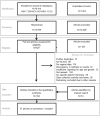Prevalence of Hepatitis B, C, and D in Germany: Results From a Scoping Review
- PMID: 33014960
- PMCID: PMC7493659
- DOI: 10.3389/fpubh.2020.00424
Prevalence of Hepatitis B, C, and D in Germany: Results From a Scoping Review
Abstract
Background: One of the five strategic directions in the World Health Organization global health sector strategy on viral hepatitis 2016-2021 is to generate strong strategic information for focused action to understand the viral hepatitis epidemic and focus the response. Knowledge of national prevalence is a cornerstone of strategic information. Germany is considered to be a low prevalence country for viral hepatitis B, C, and D, however the prevalence is likely to be higher among at-risk groups. Methods: The aim of this work was to give a detailed overview of the prevalence of viral hepatitis B (HBsAg, anti-HBc), C (anti-HCV, HCV RNA), and D (anti-HDV, HDV RNA) in different population groups in Germany. Therefore, we analyzed the results of a comprehensive literature search on various aspects of the epidemiological situation of hepatitis B, C, and D in Germany. Eligible publications including information on hepatitis B, C, and D prevalence were extracted from the overall spreadsheet table and summarized and analyzed based on virus and different population groups. A quality appraisal was performed using a checklist developed by Hoy et al. to assess risk of bias in prevalence studies. Results: Overall, 51 publications were identified through the literature search. The overall prevalence of HBsAg in the general (and proxy) population ranged from 0.3 to 1.6%. Among at-risk groups, including clinical populations and health care workers, the HBsAg prevalence ranged from 0.2% (among rheumatic patients) to 4.5% among HIV positive patients. The overall prevalence of anti-HCV in the general (and proxy) population ranged from 0.2 to 1.9%. Among at-risk groups, including clinical populations and health care workers, the anti-HCV prevalence ranged from 0.04% (among health care workers) to 68.0% among people who inject drugs. Conclusions: The hepatitis B and C prevalence in the general population in Germany is low. Prevalence is high to very high among at-risk populations, however for some groups evidence was incomplete or missing completely. To reach the elimination goals in Germany and implement a targeted response, more research among at-risk groups is needed.
Keywords: epidemiology; hepatitis B; hepatitis C; hepatitis D; prevalence; scoping review.
Copyright © 2020 Sperle, Steffen, Leendertz, Sarma, Beermann, Thamm, Simeonova, Cornberg, Wedemeyer, Bremer, Zimmermann and Dudareva.
Figures





References
-
- World Health Organization Global Hepatitis Report. (2017). 2017: Geneva.
-
- WHO Regional Office for Europe Action Plan for the Health Sector Response to Viral Hepatitis in the WHO European Region. Denmark: WHO Regional Office for Europe; (2016). p. 36.
-
- World Health Organization Global Health Sector Strategy on Viral Hepatitis 2016–2021. Geneva: (2016)
-
- Bundesministerium für Gesundheit and Bundesministerium für wirtschaftliche Zusammenarbeit und Entwicklung Strategie zur Eindämmung von HIV Hepatitis B und C und anderen sexuell übertragbaren Infektionen. Bis 2030. - Bedarfsorientiert Integriert Sektorübergreifend. Berlin: (2016).
-
- Poethko-Müller C, Zimmermann R, Hamouda O, Faber M, Stark K, Ross RS, et al. Epidemiology of hepatitis A, B, and C among adults in Germany: results of the German health interview and examination survey for Adults (DEGS1). Bundesgesundheitsblatt - Gesundheitsforschung - Gesundheitsschutz. (2013) 56:707–15. 10.1007/s00103-013-1673-x - DOI - PubMed
Publication types
MeSH terms
Substances
LinkOut - more resources
Full Text Sources
Medical

